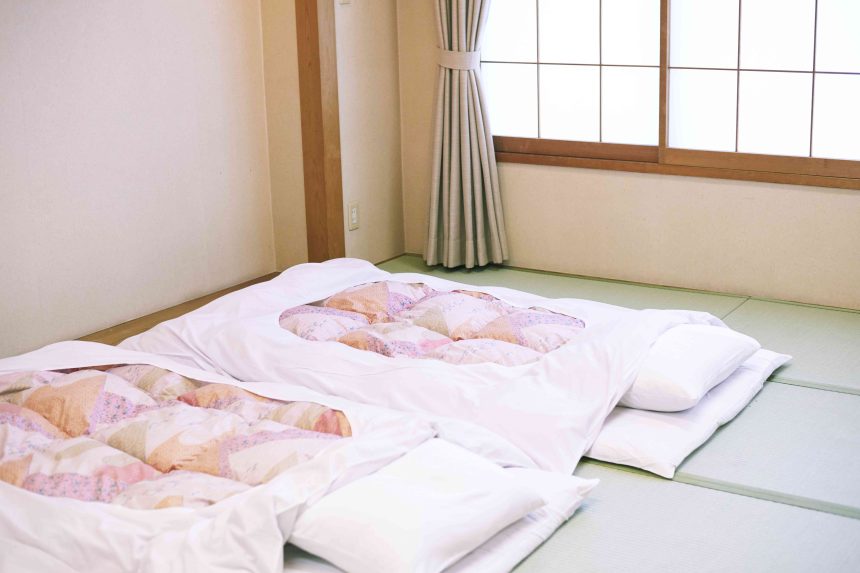According to Pinterest’s 2024 Fall Trends Report, searches for “Japanese futon bedrooms” increased by 245% last year, and unlike the lumpy, metal-frame fold-out couches commonly seen in dorm rooms, Japanese futons are a convenient and cozy option for additional seating and bedding. We spoke to experts about how to style and use a Japanese futon, so you can incorporate the cozy accent into your home.
What Is a Japanese Futon and How Does It Differ from Other Futons?
“Crafted from natural cotton, wool, and latex fibers, they are lightweight, breathable, and easily stored when rolled up,” says CEO and founder of The Futon Shop Suzanne Diamond. “This straightforward design perfectly complements the Japanese aesthetic of clean lines and neutral colors, providing comfort and functionality.”
Japanese futons look familiar to traditional futons, but that’s where the similarities end. Diamond explains that traditional Japanese futons are known as shikibutons, made with layers of cotton or wool, but the typical futon is often filled with synthetic foam and chemicals.
Brittany Griggs, a copywriter for J-Life International, a Japanese home store, says this futon is designed to be laid on a tatami mat or directly on the floor, as opposed to dorm room ones that usually perch on a bed frame. Japanese futons offer a closer connection to the simplicity and elegance of Japanese living.
“Beyond their role as bedding, futons hold a significant cultural value in Japan, representing simplicity and hospitality,” Diamond adds. “They support a healthy, natural sleeping posture and are versatile enough to double as seating areas for social gatherings, making them a great fit for contemporary, multifunctional living spaces.”
The Benefits of a Japanese Futon
“Japanese futons offer a distinct sleeping experience by encouraging proper spinal alignment and minimizing pressure points,” says Diamond. “Unlike conventional mattresses that may cause discomfort due to excessive sinking, the firm support of a shikibuton helps maintain a natural posture. This leads to better sleep quality and contributes positively to overall well-being.”
More basic futons are an inexpensive way to add seating that converts to a bed in tight spaces, but getting something functional at a low price point has its drawbacks. Japanese futons boast comfortability and remain of higher quality than one you may find in a young adult’s apartment, and they’re generally made with better materials for cushion support.
“Crafted from natural materials like organic cotton, Japanese futons are breathable and hypoallergenic,” says Diamond. “This enhances airflow and minimizes allergies, creating a cooler and more comfortable sleeping environment. For those seeking a healthy, chemical-free sleep setup, these futons are an excellent choice.”
Styling Your Futon
“Another common misconception is that futons clash with modern design aesthetics. Japanese futons are incredibly versatile and fit seamlessly into minimalist or contemporary interiors,” says Diamond. “Their simple design and natural materials align well with minimalist principles, offering functionality and aesthetic appeal. They also save space and reduce clutter, making them ideal for modern living spaces.”
While this type of futon is popular mainly for its easy storage and comfortability, it’s also gaining momentum for being aesthetically pleasing.
“The Japanese futon is experiencing a resurgence in home decor trends, largely due to the growing appeal of minimalism,” says Griggs. “As more people seek to simplify their lives and cut down on living costs, the practicality and elegance of Japanese living become increasingly attractive.”
You can achieve a minimalist look with your futon by styling other elements of your space accordingly. Griggs recommends pairing the futon with tatami mats, low wooden furniture, and soft, neutral-toned textiles to create a serene, zen-like space. You could even pair them with Japanese tansu tables, commonly used in Japanese interiors.
“In a modern interior, use the futon as a statement piece on a minimalist platform or directly on polished floors, complemented by clean lines and contemporary decor to achieve a chic, understated look,” Griggs adds.
Maintenance Is a Must
Keeping your futon clean will ensure it remains comfortable and lasts for years to come. And like a traditional bed mattress, you should rotate and flip your futon regularly, ideally each week, to maintain its shape and support.
“It’s recommended to air out your futon by placing it in direct sunlight a minimum of two times per year, as this helps eliminate moisture and keeps it fresh,” says Griggs.
Griggs also recommends pairing your futon with other traditional Japanese bedding elements, such as hypoallergenic silk kakefuton duvets, washable silk bedding, and soba gara makura (buckwheat) pillows—and don’t forget a protective cover to prevent stains and spills.






